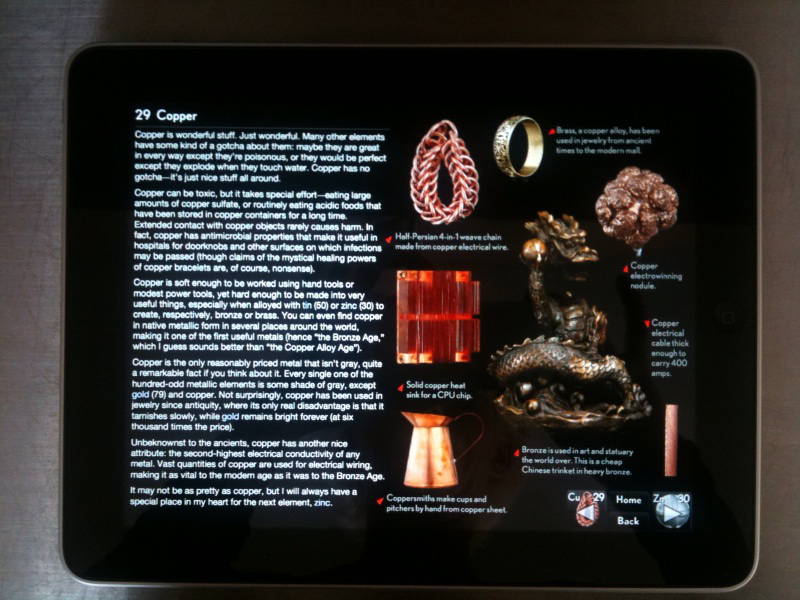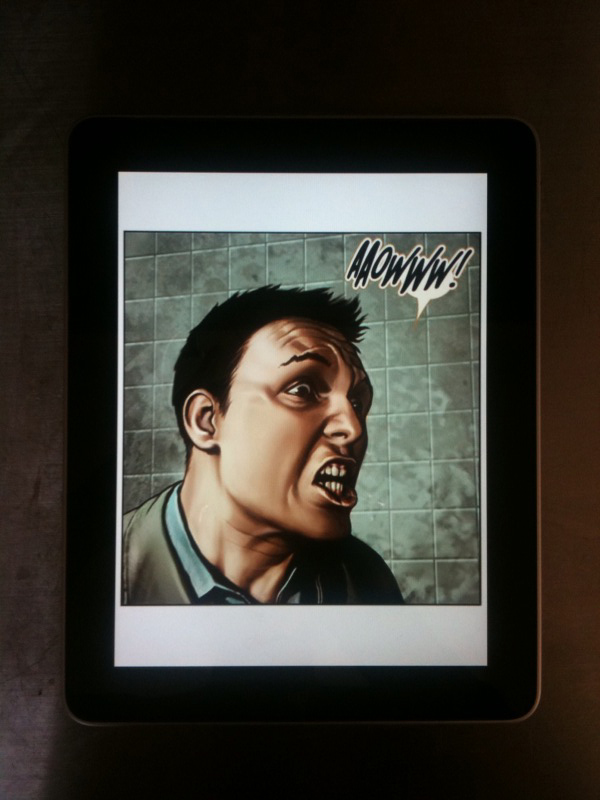Sent to you by Sparkie via Google Reader:
 It strikes you when you first touch an iPad. The form just feels good, not too lightweight or heavy, nor too thin or thick. It's sensual. It's tactile. And that moment is a good way to spot a first-timer, too, as I observed with a few test subjects. The dead giveaway for an iPad n00b is a pause, a few breaths before hitting the "on" switch, just letting it rest against the skin. Flick the switch and the novelty hits. Just as the iPhone, Palm Pré and Android phones scratched an itch we didn't know we had—somewhere between cellphone and notebook—the iPad hits a completely new pleasure spot. The display is large enough to make the experience of apps and games on smaller screens stale. Typography is crisp, images gem-like, and the speed brisk thanks to Apple's A4 chip and solid state storage. As I browse early release iPad apps, web pages, and flip through the iBook store and books, the thought hits that this is a greater leap into a new user experience than the sum of its parts suggests.
It strikes you when you first touch an iPad. The form just feels good, not too lightweight or heavy, nor too thin or thick. It's sensual. It's tactile. And that moment is a good way to spot a first-timer, too, as I observed with a few test subjects. The dead giveaway for an iPad n00b is a pause, a few breaths before hitting the "on" switch, just letting it rest against the skin. Flick the switch and the novelty hits. Just as the iPhone, Palm Pré and Android phones scratched an itch we didn't know we had—somewhere between cellphone and notebook—the iPad hits a completely new pleasure spot. The display is large enough to make the experience of apps and games on smaller screens stale. Typography is crisp, images gem-like, and the speed brisk thanks to Apple's A4 chip and solid state storage. As I browse early release iPad apps, web pages, and flip through the iBook store and books, the thought hits that this is a greater leap into a new user experience than the sum of its parts suggests.Remember The Periodic Table of Elements series of books we featured here at Boing Boing? There's an iPad version ($13.99 in the app store, screenshots here), and it's dazzling — it makes science feel like magic in your hands. I called the guy behind The Elements, Theo Gray, and asked him to put into words the UI magic that iPad makes possible for creators of books, games, news, and productivity tools.
"The Elements on iPad is not a game, not an app, not a TV show. It's a book. But it's Harry Potter's book. This is the version you check out from the Hogwarts library. Everything in it is alive in some way."
Indeed, the elements in this periodic table seem very much alive. The obvious way to examine static objects — say, a lump of gold (number 79) or an ingot of cast antimony (number 51) is to rotate them, to spin the specimen with your fingertips. And that's exactly what you do here. You can view them in 3D if you wish, with 3D glasses you buy separately online. Tap here, and live data from Wolfram Alpha pops up (the thermodynamic properties of molybednum, perhaps, or the current price of platinum). Some elements are presented with little video clips you can play, too.
When you get a chance, compare it to the tiny screen of an iPhone or Droid, or the less responsive touchscreens of an all-in-one desktop PC such as HP's TouchSmart: it's a completely different experience.
"A stereo 3D video of a static object that you can rotate in real time," Theo says over the phone. "Honestly, I'm not sure where you go from there. Smellovision? Not a whole lot more you can do."
The Elements presentation for iPad (those spinning samples of elements you twirl with your fingertip) makes use of openGL textures, compressing visual data in a way that can be compressed in the graphics chip, so the data can be read without hogging CPU resources. By making use of hardware native to iPad, you can can "play" a spin forwards and backwards with no hiccups or performance lags -- even spin 3, 4, 5, 10 views of an element at a time. This ain't Flash video over WiFi, folks. You'll feel sad going back to chokey http embeds.

Each app for iPad can't be more than 2 gigs in compressed archive form (a limitation imposed by the zip compression standard at work here, not something of Apple's own design). Data-dense applications like The Elements buck right up against that limit, but future iterations (this and others that go live Saturday were developed with great haste) will likely take advantage of the ability to do background downloading to supplement data.
Tapping and swirling my way through iBooks (the store includes free, public domain titles in addition to the $9.99-$12.99 bestsellers), and iPad native apps provided at launch such as the spectacular, game-changing Marvel Comics app (crisp, lucid art, the ability to navigate frame-by-frame, rendering spoilers down the page obsolete), the Epicurious recipe browser, and the news browsing app by Reuters (free app in which video is, again, a seamless delight), the idea hits. This is what we wanted e-books to be all along. Rich, nimble, and dense with image and sound and navigability, right there inside the flow of the story. And this is what we wanted the web to feel like all along. We just want it to work, and we don't want to be aware of the delivery method while we're enjoying what's delivered.
Theo's been thinking about all of this, too. "The Kindle is a great device, and I own several," Theo says. "But the concept of an e-book has always been that it's like PDF. Imagine if the web standard was PDF instead of html, if everyone's web pages consisted of what you can do in PDF? That would be a really boring world. I hate to see ebooks as being pigeonholed as these static, PDFlike things, in which the biggest 'a-ha' you can have is an exciting pageturning animation, or search. What could an ebook be? Let's draw a line in the sand out in the future and say, this is the greatest aspiration, if the limitations of code and hardware were no object."
Draw that imaginary line in the sand, and you've sketched out iPad.

Manic, nonstop use revealed a number of things: battery life is better than I anticipated. I got a full day of constant internet-connected use (it did not leave my hands) on one charge. More than 12 hours, with heavy video and gaming, and screen cranked up to full brightness.
Orientation lock is great for when I'm sharing YouTube clips on the couch with family, or web browsing in bed. It fits well in my lap for tweeting when eating during lunch break, and it's easy to wipe off a stray mayo glop and get right back to updating the world on the details of my sandwich (using Twitterific for iPad, a free app which does what it promises on the tin). When we began developing the Boing Boing iPad presentation, we used a simulator and tapped into a lot of jQuery, thinking that snazzy transitional animations would delight. They didn't: it worked great on the Mac simulator, but were sluggish on iPad, so we aborted and went simple. When you're redesigning a site for iPad, you start to think in terms of a visually rich 'zine, not a website. Given Boing Boing's 'zine roots (25 years and counting since the first Xeroxed copy), the close of that evolutionary circle is something that makes me smile.

Familiar Mac fundamentals like Calendar, Keynote, Pages, and Numbers are presented thoughtfully with the kinetic and tactile specifics of iPad in mind. Pinch-zoom the preview image for a photo album you've saved, and watch the contents scatter out accross the screen, so you can be reminded of the shots you've stored inside.
Gaming possibilities are profound. Accelerometer-driven games like the Real Racing HD iPad app ($9.99) available at first release thrill in a new way, like when I first held a Wii. There's something about tilting and steering and braking with a device you hold in your hands, just like a steering wheel, that's so much more viscerally pleasing than a big old shelf-bound console.
The on-screen QWERTY keyboard is more finger-sized than iPhone (obviously, the screen's larger when either in portrait or landscape) but I didn't find myself using the device for lots of text input (email, blog post composing) without the aid of the keyboard dock— pretty much exactly like the standard Mac keyboard. No, there's no camera, but it doesn't seem like as much of a big deal as when I heard that news back at the January unveiling. iPad is more about experiencing media, and light sharing, than heavy-duty media production.
That said, I can imagine traveling with iPad instead of a netbook, with that keyboard dock in tow if I really need to do heavy text input.

Maybe the most exciting thing about iPad is the apps that aren't here yet. The book-film-game hybrid someone will bust out in a year, redefining the experience of each, and suggesting some new nouns and verbs in the process. Or an augmented reality lens from NASA that lets you hold the thing up to the sky and pinpoint where the ISS is, next to what constellation, read the names and see the faces of the crew members, check how those fuel cells are holding up.
I like it a lot. But it's the things I never knew it made possible — to be revealed or not in the coming months — that will determine whether I love it.




Things you can do from here:
- Subscribe to Boing Boing using Google Reader
- Get started using Google Reader to easily keep up with all your favorite sites
No comments:
Post a Comment